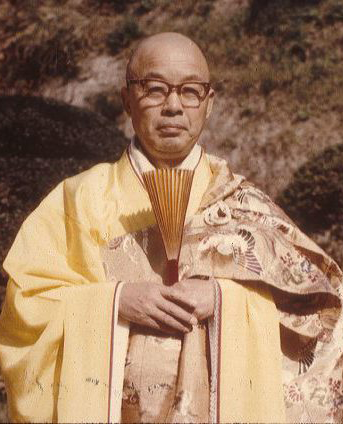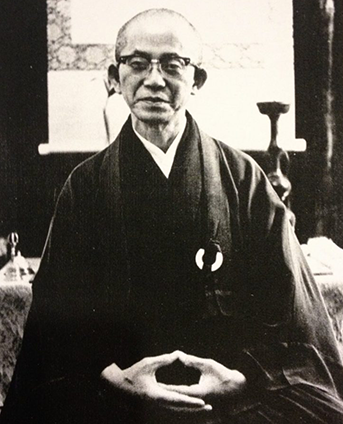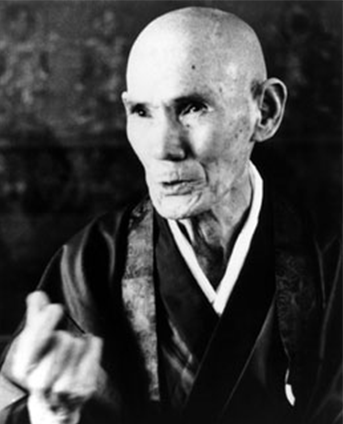Our Founder
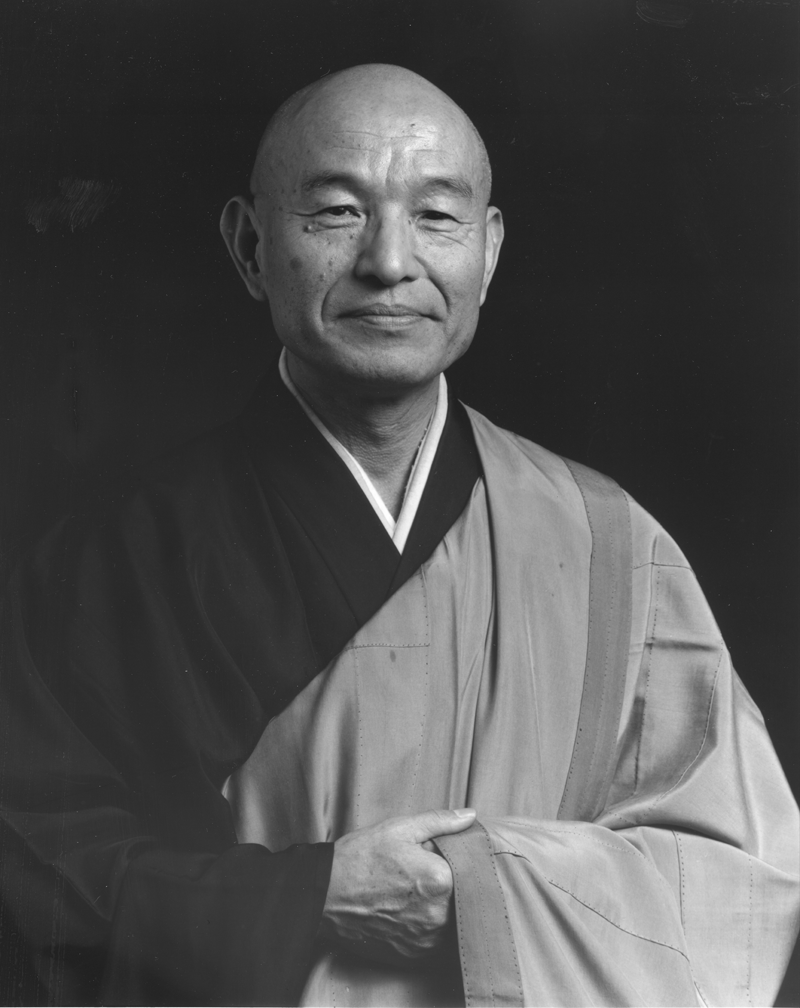
TAIZAN MAEZUMI ROSHI, 1931-1995
The Venerable Hakuyu Taizan Maezumi Roshi, a seminal influence on the growth of Zen Buddhism in the United States, was ordained as a Soto Zen monk at the age of eleven. He received degrees in Oriental Literature and Philosophy from Komazawa University and trained at Sojiji, one of the two main Soto monasteries in Japan. In 1956, Maezumi Roshi came to Los Angeles as a priest at Zenshuji Temple, the Soto Headquarters of the United States. He devoted his life to laying a firm foundation for the growth of Zen Buddhism in the West.
In 1967, he established the Zen Center of Los Angeles. Its honorary founder is Baian Hakujun Daiosho, who headed the Soto Sect Supreme Court and was one of the leading figures of Japanese Soto Zen.
In 1976, Maezumi Roshi established the Kuroda Institute for the Study of Buddhism and Human Values, an educational non-profit that promotes scholarship on Buddhism in its historical, philosophical, and cultural ramifications. The Institute also publishes a book series with the University of Hawaii Press devoted to the translation of East Asian Buddhist classics and presentations of scholarly works from its conferences.
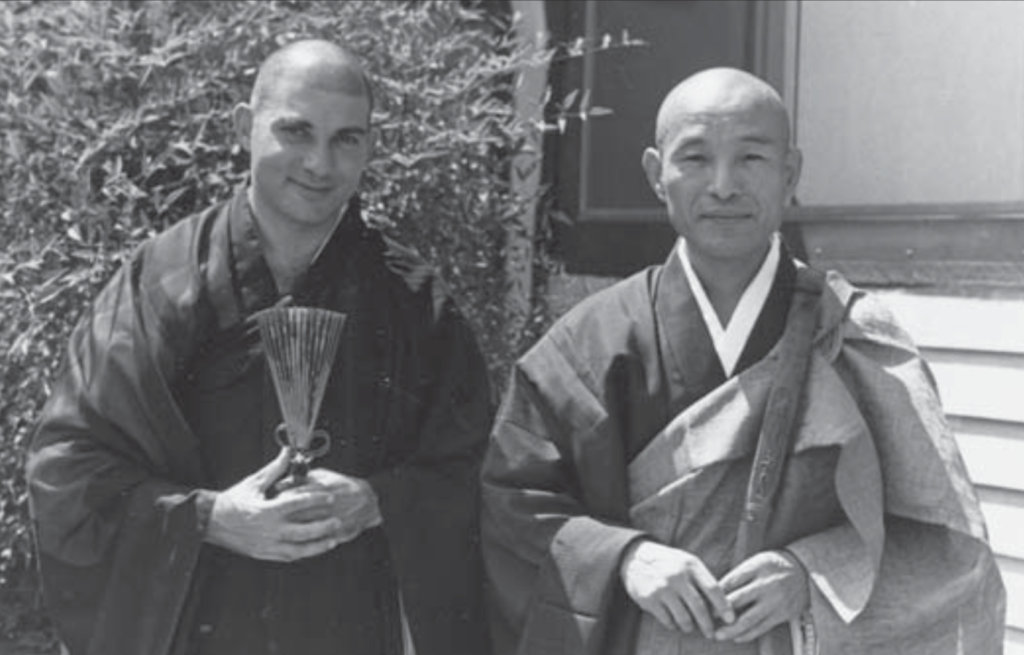
BERNIE TETSUGEN GLASSMAN AND TAIZAN MAEZUMI
Conceived of informally in 1979 by Maezumi and Bernard Tetsugen Glassman, the White Plum Asanga was named after Maezumi’s father Baian Hakujun Dai-osho and then later incorporated in 1995 following Maezumi’s death. Bernie Glassman was the White Plum Asanga’s first President.
“Asanga” or “outside (a) the Sangha (sanga)” implies “without attachment”— a play on words chosen by Maezumi Roshi and Bernie Glassman.
He transmitted the Dharma to twelve successors: Bernard Tetsugen Glassman, Dennis Genpo Merzel, Charlotte Joko Beck, Jan Chozen Bays, John Daido Loori, Gerry Shishin Wick, John Tesshin Sanderson, Alfred Jitsudo Ancheta, Charles Tenshin Fletcher, Susan Myoyu Andersen, Nicolee Jikyo Miller, and William Nyogen Yeo.
These twelve successors have now further transmitted the Dharma to multiple “second-generation” successors, up to five generations deep. In America, Maezumi Roshi ordained 68 Zen priests and gave lay Buddhist precepts to over 500 people.

BERNIE TETSUGEN GLASSMAN AND TAIZAN MAEZUMI
Conceived of informally in 1979 by Maezumi and Bernard Tetsugen Glassman, the White Plum Asanga was named after Maezumi’s father Baian Hakujun Dai-osho and then later incorporated in 1995 following Maezumi’s death. Tetsugen Bernard Glassman was the White Plum Asanga’s first President.
“Asanga” or “outside (a) the Sangha (sanga)” implies “without attachment”— a play on words chosen by Maezumi Roshi and Bernie Glassman.
He transmitted the Dharma to twelve successors: Bernard Tetsugen Glassman, Dennis Genpo Merzel, Charlotte Joko Beck, Jan Chozen Bays, John Daido Loori, Gerry Shishin Wick, John Tesshin Sanderson, Alfred Jitsudo Ancheta, Charles Tenshin Fletcher, Susan Myoyu Andersen, Nicolee Jikyo Miller, and William Nyogen Yeo.
These twelve successors have now further transmitted the Dharma to multiple “second-generation” successors, up to five generations deep. In America, Maezumi Roshi ordained 68 Zen priests and gave the lay Buddhist precepts to over 500 people.
Maezumi Roshi received Dharma transmission from Hakujun Kuroda, Roshi, in 1955. In 1970, he received Dharma Transmission from Yasutani Roshi, and in 1973, from Koryu Roshi. Thus, Maezumi Roshi became one of few teachers to receive Inka (approval as a teacher) from both the Inzan and Takuju Rinzai lineages, as well as Dharma Transmission in the Soto lineage.

BERNIE TETSUGEN GLASSMAN AND TAIZAN MAEZUMI
Conceived of informally in 1979 by Maezumi and Tetsugen Bernard Glassman, the White Plum Asanga was named after Maezumi’s father Baian Hakujun Dai-osho and then later incorporated in 1995 following Maezumi’s death. Tetsugen Bernard Glassman was the White Plum Asanga’s first President.
“Asanga” or “outside (a) the Sangha (sanga)” implies “without attachment”— a play on words chosen by Maezumi Roshi and Bernie Glassman.
He transmitted the Dharma to twelve successors: Bernard Tetsugen Glassman (NY), Dennis Genpo Merzel (UT & Europe), Charlotte Joko Beck (CA), Jan Chozen Bays (OR), John Daido Loori (NY), Gerry Shishin Wick (CO), John Tesshin Sanderson (Mexico), Alfred Jitsudo Ancheta (CA), Charles Tenshin Fletcher (CA), Susan Myoyu Andersen (IL), Nicolee Jikyo Miller (CA), and William Nyogen Yeo (CA).
These twelve successors have now further transmitted the Dharma to multiple “second-generation” successors. In America, Maezumi Roshi ordained 68 Zen priests and gave the lay Buddhist precepts to over 500 people.
Maezumi Roshi established six temples in the United States and Europe that are formally registered with Soto Headquarters in Japan.
In addition to ZCLA, these include:
- Zen Mountain Center in California
- Zen Community of New York
- Kanzeon Zen Centers (Salt Lake City, Utah and Europe)
- Zen Mountain Monastery in New York
Other affiliated centers include:
- Great Mountain Zen Center in Colorado,
- Zen Community of Oregon
- Three Treasures Zen Community in San Diego
- Centro Zen de Mexico, Coyoacan
- Centro Zen de la Cuidad de Mexico
In addition, there are now over fifty groups in the Americas and Europe that are affiliated with the White Plum Asanga.
As a major contribution to the transmission of Buddhist teachings to the West, Maezumi Roshi was also instrumental in bringing to realization the formation of the Soto Zen Buddhist Association (SZBA) of American Soto Zen teachers. He also promoted exchange programs among priests and lay practitioners between the United States and Japan. He had published commentaries on major Buddhist works, and his collected works will be published posthumously. Maezumi Roshi also founded the Dharma Institute in Mexico City.
At the age of 64 Maezumi Roshi died suddenly in Tokyo, Japan in the early morning hours of Monday, May 15 (Japanese time), 1995. Maezumi Roshi was survived by his wife Martha Ekyo Maezumi (1947-2022) and their three children, Kirsten Mitsuyo, Yuri Jundo and Shira Yoshimi.
Intimate funeral services and cremation were held in Tokyo, Japan on May 19 to 20, 1995. The main funeral was held on Sunday, August 27, 1995 in Los Angeles, California.
Maezumi Roshi established six temples in the United States and Europe that are formally registered with Soto Headquarters in Japan.
In addition to ZCLA, these include:
- Zen Mountain Center in California
- Zen Community of New York
- Kanzeon Zen Centers (Utah and Europe)
- Zen Mountain Monastery in New York
Other affiliated centers include:
- Great Mountain Zen Center in Colorado,
- Zen Community of Oregon
- Three Treasures Zen Community in San Diego
- Centro Zen de Mexico, Coyoacan
- Centro Zen de la Cuidad de Mexico
In addition, there are now over fifty groups in the Americas and Europe that are affiliated with the White Plum Asanga.
As a major contribution to the transmission of Buddhist teachings to the West, Maezumi Roshi was also instrumental in bringing to realization the formation of the Soto Zen Buddhist Association (SZBA) of American Soto Zen teachers. Maezumi Roshi promoted exchange programs among priests and lay practitioners between the United States and Japan. He had published commentaries on major Buddhist works, and his collected works will be published posthumously. Maezumi Roshi also founded the Dharma Institute in Mexico City.
At the age of 64 Maezumi Roshi died suddenly in Tokyo, Japan in the early morning hours of Monday, May 15 (Japanese time), 1995. Maezumi Roshi was survived by his wife Martha Ekyo Maezumi (1947-2022) and their three children, Kirsten Mitsuyo, Yuri Jundo and Shira Yoshimi.
Intimate funeral services and cremation were held in Tokyo, Japan on May 19 to 20, 1995. The main funeral was held on Sunday, August 27, 1995 in Los Angeles, California.
Maezumi Roshi established six temples in the United States and Europe that are formally registered with Soto Headquarters in Japan.
In addition to ZCLA, these include:
- Zen Mountain Center in California
- Zen Community of New York
- Kanzeon Zen Centers (Utah and Europe)
- Zen Mountain Monastery in New York
Other affiliated centers include:
- Great Mountain Zen Center in Colorado,
- Zen Community of Oregon
- Three Treasures Zen Community in San Diego
- Centro Zen de Mexico, Coyoacan
- Centro Zen de la Cuidad de Mexico
In addition, there are now over fifty groups in the Americas and Europe that are affiliated with the White Plum Asanga.
As a major contribution to the transmission of Buddhist teachings to the West, Maezumi Roshi was also instrumental in bringing to realization the formation of the Soto Zen Buddhist Association (SZBA) of American Soto Zen teachers. Maezumi Roshi promoted exchange programs among priests and lay practitioners between the United States and Japan. He had published commentaries on major Buddhist works, and his collected works will be published posthumously. Maezumi Roshi also founded the Dharma Institute in Mexico City.
At the age of 64 Maezumi Roshi died suddenly in Tokyo, Japan in the early morning hours of Monday, May 15 (Japanese time), 1995. Maezumi Roshi was survived by his wife Martha Ekyo Maezumi (1947-2022) and their three children, Kirsten Mitsuyo, Yuri Jundo and Shira Yoshimi.
Intimate funeral services and cremation were held in Tokyo, Japan on May 19 to 20, 1995. The main funeral was held on Sunday, August 27, 1995 in Los Angeles, California.

